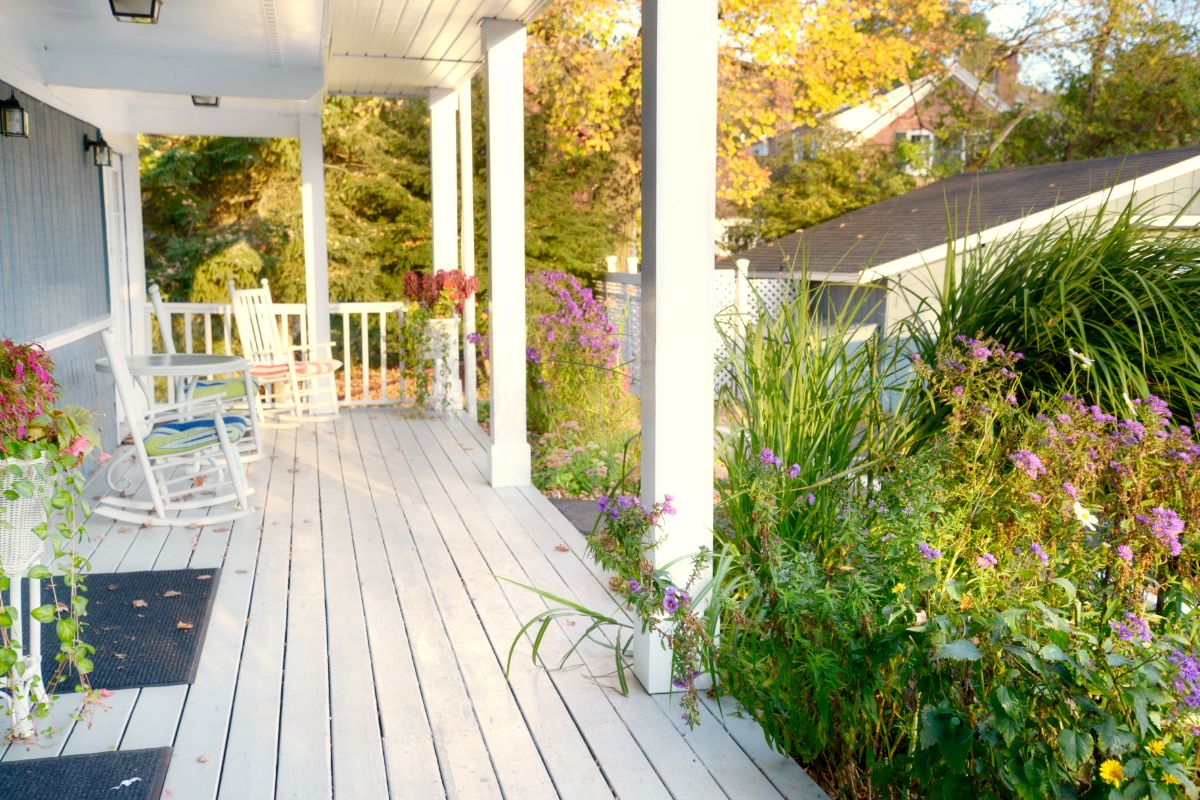Whether you want to create a cozy space for reading, entertaining guests, or simply relaxing, a porch is a versatile addition to your house.
If you don’t already have one, now might be the time to start thinking about adding one to your property – and it is likely to be much easier than you anticipate.

A porch adds character to your home and helps define its architectural style.
Whether you choose to go with a classic look or opt for modern design, there are plenty of ways to create your own porch; read on for our top tips, and enjoy a new addition to your home in no time!
How To Build A Porch: The Steps
There are a number of steps involved in creating a porch, and we are here to walk you through them.
1. Obtain Any Permits
The first step in building your new porch is to make sure that you obtain any required permits or licenses – this will ensure that your project goes smoothly from beginning to end.
You may need permission from your local council if you intend to build an extension onto your existing dwelling, but it is also possible to apply for planning permission for a standalone structure.
Make sure you do some research before you get started, and cover all the legal necessities – this will prevent you from getting bogged down in red tape later on or, worse of all, being forced to remove your porch once it is in place.
2. Choose Your Porch Style
Once you have obtained any necessary permissions, you can begin to think about what type of porch you would like to add to your home.
There are many different styles available, including traditional, contemporary, country cottages, and more.
Each has its own unique features, so take some time to consider which style best suits your needs.
If you are looking to create a comfortable space for yourself, then a traditional-style porch could be just what you are after.
Traditional porches tend to be fairly simple, made of natural wood, and will offer plenty of space.
A more contemporary porch, on the other hand, may use metals, concrete, or other materials that create a modern look, and may include lighting fixtures and other decorative elements.
Whatever style you decide upon, remember that you should always select something that fits well within the overall aesthetic of your home.
3. Select Your Materials
Now that you know what kind of porch you would like, you can start shopping around for the right materials.
This is where things can get tricky, as there are many different types of wood, stone, concrete, and metal out there, each with its own pros and cons.
For example, wooden porches are very popular, but they require regular maintenance and upkeep.
They are also prone to warping and rotting over time, and therefore may not last forever.
On the other hand, concrete porches are easy to install and can withstand extreme weather conditions.
However, they are expensive and can become slippery when wet. When choosing your materials, keep these points in mind:
Longevity
How long do you want your porch to last? If you plan to live in your house for several years, then you will probably want to invest in quality materials.
Remember that good-quality materials will help protect your investment, and will give you peace of mind knowing that your porch won’t fall apart anytime soon.
Budget
What is your budget? Do you have enough money to buy a high-end material, or do you prefer to spend less for a result that still looks great, but may not last for as long?
It’s important to find a balance between affordability and quality, and you may have to compromise somewhere along the way.
Neighborhood

What will your neighbors think?
If you’re planning on building a porch that sticks out from the rest of your home, then you’ll likely want to choose a material that blends in with the surrounding area.
For instance, if you live in an older neighborhood, you might want to avoid using something ultra-modern – this could cause tension and issues with your neighbors.
4. Choose The Right Size And Location
Once you’ve decided on the type of porch you’d like to build, you need to figure out how big you want it to be.
You’ll want to make sure that the size of your porch matches the needs of your family, and that it doesn’t take up too much room in your home.
If you are planning on sitting outside often, then you’ll want to consider installing a large porch.
However, if you only plan on spending part of the year outdoors, then you may want to opt for a smaller porch.
You’ll also want to determine whether you want a covered or uncovered porch.
An uncovered porch is easier to maintain, but it does mean that you’ll have to deal with rain and snow more frequently.
Covered porches are better for protecting against the elements, but they tend to cost more than their uncovered counterparts.
5. Decide How You Want To Install Your Porch
There are two main ways to go about installing a porch: DIY (do-it-yourself) installation, and professional installation.
DIY installation is usually cheaper than professional installation, but it requires some skill and experience.
This means that you could end up wasting a lot of time and money if you don’t know what you’re doing.
Professional installation is generally recommended because it comes with many benefits, including a trained crew with professional equipment, as well as insurance coverage if anything goes wrong.
6. Get Ready For Construction
Now that you’ve chosen your materials, location, and size, it’s time to get ready for construction!
Before you start any project, you should always check with local codes and regulations.
Some cities and states require permits before you can begin work, so make sure that you know where you stand before you start.
7. Start Building
The first step in constructing your porch is to lay down the foundation. Once you’ve done this, you’ll need to install the frame of your porch.
8. Add Walls & Flooring
After you’ve installed the frame, you’ll need to add walls and flooring. Depending on your choice of material, you may need to hire a contractor to help you install these items.
9. Finish Up
After you’ve finished adding all of the necessary components, you’ll need to finish off your porch by painting it and applying a trim.
10. Enjoy Your New Space
When your porch is complete, you’ll finally be able to enjoy it.
Whether you use it every day or just occasionally, having a porch at your home will give you a place to relax after a long day.
Final Thoughts
Building a porch gives you a great space to spend time outdoors, and it adds value to your home – and it doesn’t have to be a stressful process!
- How To Drill Into Brick? - October 31, 2022
- How To Repair And Refinish Hardwood? - October 31, 2022
- Floetrol – What Is It? When To Use It: Complete Guide - October 31, 2022
